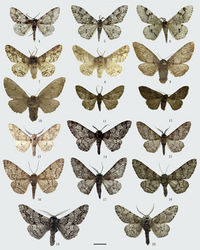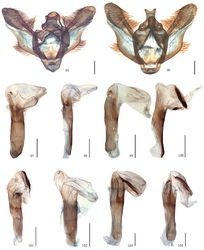Biston robustum
| Notice: | This page is derived from the original publication listed below, whose author(s) should always be credited. Further contributors may edit and improve the content of this page and, consequently, need to be credited as well (see page history). Any assessment of factual correctness requires a careful review of the original article as well as of subsequent contributions.
If you are uncertain whether your planned contribution is correct or not, we suggest that you use the associated discussion page instead of editing the page directly. This page should be cited as follows (rationale):
Citation formats to copy and paste
BibTeX: @article{Jiang2011ZooKeys139, RIS/ Endnote: TY - JOUR Wikipedia/ Citizendium: <ref name="Jiang2011ZooKeys139">{{Citation See also the citation download page at the journal. |
Ordo: Lepidoptera
Familia: Geometridae
Genus: Biston
Name
Biston robustum Butler, 1879 – Wikispecies link – Pensoft Profile
- Biston robustum Butler, 1879[1], Ann. Mag. nat. Hist., (5) 4: 371. Syntype(s), Japan: Yokohama. (BMNH)
- Biston robustum kiangsua Wehrli, 1941[2], in Seitz, Gross-Schmett. Erde, 4 (Suppl.): 433, pl. 36: b. Holotype ♂, China: Shanghai. (ZFMK) (Treated as a synonym of Biston robustum robustum by Parsons et al. (1999)[3])
Diagnosis
The external characters of this species are close to those of Biston porphyria (Butler, 1889) (India) as follows: the male antennae are bipectinate to tip; greyish brown bands are present basally of the antemedial line of the forewing and distally of the postmedial lines of both wings; the forewing medial line converges with the postmedial line at 1A + 2A; the hindwing postmedial line acutely protrudes between M1 and M3; the submarginal lines of both wings are dark grey. But the species can be distinguished by the following characters: this species (length of forewing: 28–30 mm in male) is larger than Biston porphyria; the wings are broader; the hindwing medial line is more conspicuous. The male genitalia of the species are similar to those of Biston betularia as follows: the apex of the uncus is bifurcated; the median process of the gnathos is about one-half length of the uncus; the juxta is long, narrow, and acute apically. But it can be distinguished from Biston betularia by the longer and narrower valva and the absence of cornuti.
Material examineds
CHINA, Shanghai (ZFMK): 1♂ (Holotype of Biston robustum kiangsua). Shandong (IZCAS): Gujiding, 13.IV.1981, 3♂. Jiangsu (IZCAS): Nanjing, Qixiaqu, Yaohuamen, 16.III.2006, coll. Lang Songyun, 3♂. More material from Shaanxi, 2♂ from Taiwan, many from Japan, 2♂ from Korea and many from Vietnam in coll. ZFMK.
Distribution
China (Shandong, Shaanxi, Shanghai, Jiangsu, Jiangxi, Taiwan), Japan, Russia, North Korea, South Korea, Vietnam.
Remarks
There are two Chinese subspecies of Biston robustum, they are Biston robustum robustum Butler, 1879 and Biston robustum subrobustum Inoue, 1964 (Biston robustum subrobustum Inoue, 1964, Kontyû, 32 (2): 338, pl. 8, fig. 3. Holotype ♂, Taiwan (central): Puli. (BMNH)). The former is distributed in the mainland China, the latter is distributed in Taiwan. The description of Biston robustum kiangsua Wehrli was based on a single, rather aberrant specimen, with a single printed label “Shanghai China”. Similar forms occur in Japan, as mentioned by Wehrli (1941). So this name very probably does not denote a valid subspecies and it is synonymized correctly.
Taxon Treatment
- Jiang, N; Xue, D; Han, H; 2011: A review of Biston Leach, 1815 (Lepidoptera, Geometridae, Ennominae) from China, with description of one new species ZooKeys, 139: 45-96. doi
Other References
- ↑ Butler A (1879) List of species in a small collection of butterflies from the South Seas. Annals and Magazine of Natural History (5) 4: 357–361.
- ↑ Wehrli E (1938–1954) Subfamilie: Geometrinae. In: Seitz A (Ed) Die Grossschmetterlinge der Erde. Vol. 4 (Supplement), Verlag A. Kernen, Stuttgart, 254–766, taf. 19–53.
- ↑ Parsons M, Scoble M, Honey M, Pitkin L, Pitkin B (1999) The catalogue. In: Scoble M (Ed). Geometrid moths of the world: a Catalogue (Lepidoptera, Geometridae). CSIRO, Collingwood: 1-1016.
Images
|


